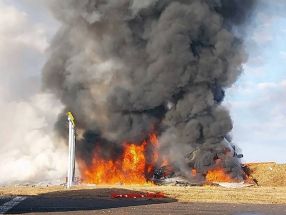Air Force offers details of bomber training zone
BILLINGS, Mont. — Any given location across a sprawling area of the Northern Plains could see up to nine low-altitude overflights by military aircraft annually under a proposed expansion of an Air Force bomber training area detailed Friday.
Supersonic flights in the area would be limited to 10 days a year during large-scale exercises involving roughly 20 aircraft. Civilian flights would face sharp restrictions during those times.
Details of the Air Force plan emerged with the release of a long-awaited, 502-page environmental study of a proposal in the works since 2006.
The Powder River training area now spans about 8,300 square miles and can accommodate only one or two bombers at a time.
A much larger area that could be occupied by 20 bombers, fighters and tankers at once would create a more realistic environment where crews "would more readily train as they will fight," the Air Force study concluded.
The Air Force wants to triple the size of its Powder River Training Complex to roughly 28,000 square miles. That's a larger area than West Virginia and would include airspace over Montana, Wyoming and the Dakotas.
It would be used by B-1 and B-52 bombers and could save the military $23 million a year by reducing the number of sorties now being sent to Utah and Nevada for exercises, officials said.
Friday's study release kicked off a 30-day waiting period until a final decision is made by the Air Force. Federal Aviation Administration approval also is needed.
Elected officials from South Dakota have been supportive of the proposal. Republican U.S. Sen. John Thune has described the expansion as vital to keeping open Ellsworth Air Force Base near Rapid City.
But it has faced strong resistance from Montana elected leaders and state aviation officials. They say more bombers — conducting maneuvers and dropping flares and chaff as they roar overhead in that portion of the state — would disrupt rural communities and scare livestock.
They also argued that it could interfere with civil air traffic and hurt businesses in the area of the expansion. North Dakota officials also have raised concerns about potential impacts on civilian flights.
Friday's study signaled the Air Force is preparing to push ahead with its proposal, notwithstanding the objections.
The Air Force acknowledged in its study that the low-altitude flights and loud sonic booms have the potential to startle ranchers, recreationists and American Indians living on four reservations in the region.
But it said those disruptions largely would be sporadic and temporary.
Alee Lockman, a spokeswoman for U.S. Rep. Steve Daines, a Montana Republican and U.S. senator-elect, said there still was time for the plan to be altered.
"This is one of the last stops in the process. It's a significant step," Lockman said. "We will continue putting pressure on the Air Force to make changes before any expansion actually moves forward."
U.S. Sen. Heidi Heitkamp, D-North Dakota, said in a statement that the expansion will help increase training and readiness for the Air Force. She said it needs to strike a balance between national security and economic and safety concerns.
A B-1B from Ellsworth Air Force Base crashed in August of 2013 in southeastern Montana near Broadus — within the existing bounds of the training area. Four crew members ejected from the high-speed aircraft and survived.
- Latest
- Trending
































